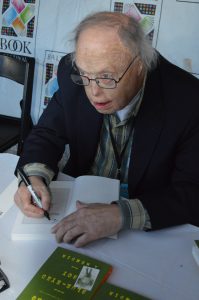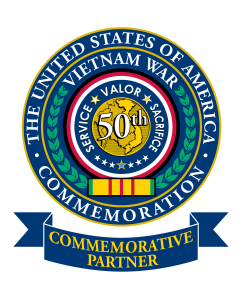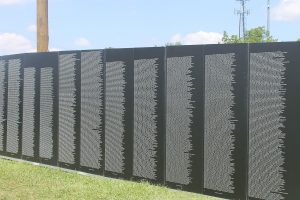Vietnam War Commemoration continues to honor veterans
A nurse who served during the Vietnam War is pinned by Vietnam War Commemoration staff member while visiting the booth. She and over 400 other Vietnam Veterans attended the 3rd annual Welcome Home Vietnam Veterans Day event hosted by the Hospice of the Chesapeake in Greenbelt, Maryland, March 30, 2017. (Photo courtesy of Sandrine Silverman)
In his heart-wrenching memoir about the trials he experienced during and after his time in Vietnam, my late friend Robert Timberg recounted his early disenchantment with the war, while observing one Vietnamese farmer:
“I don’t know if we Americans were doing anything worthwhile in Vietnam. Seems like when I first got there I saw this old peasant ankle deep in a rice paddy, walking behind a plow pulled by a water buffalo. And I kept seeing him every couple of months, never in the same place, him and his water buffalo just plowing a rice paddy – a pair from central casting. He always had his back to me, so I never saw his face. In between sightings, though, my battalion engaged in search-and-destroy operations, convoy duty, resupply missions. And we’d get intelligence briefings that said the Vietcong were on the run, or lying in wait for us behind the next ridgeline.
“Then I’d see the old guy again, him and his water buffalo, never giving any indication that a bunch of Marines armed to the teeth were half a football field away, or that anything we had done since I last saw him had had any impact on his life. I would have felt better if once, just once, he had taken off his wide-brimmed peasant hat and waved to us – or spit at us or given us the finger – but he never did. It was as if we weren’t even there.”

For many veterans of the Vietnam War, that fruitless feeling followed them home. There was no hearty “Thank You” from a grateful nation – in fact, the opposite was often true. And while veterans from previous conflicts spoke proudly of avenging Pearl Harbor and defeating Hitler, the Vietnam vets mostly kept to themselves.
It’s taken several decades for the American public to really grasp what happened in Vietnam. And nearly as long for politicians to fully embrace the idea of truly welcoming the veterans home.
The 2008 National Defense Authorization Act authorized the Secretary of Defense to conduct a program to commemorate the 50th anniversary of the Vietnam War. Now ten years in, the commemorative program is continuing its steady march, with activities and ceremonies meant to achieve the following objectives:
To thank and honor veterans of the Vietnam War, including personnel who were held as prisoners of war (POW), or listed as missing in action (MIA), for their service and sacrifice on behalf of the United States and to thank and honor the families of these veterans.
To highlight the service of the Armed Forces during the Vietnam War and the contributions of Federal agencies and governmental and non-governmental organizations that served with, or in support of, the Armed Forces.
To pay tribute to the contributions made on the home front by the people of the United States during the Vietnam War.
To highlight the advances in technology, science, and medicine related to military research conducted during the Vietnam War.
To recognize the contributions and sacrifices made by the allies of the United States during the Vietnam War.
In order to understand more about the Vietnam War Commemoration and the impact it is having in the lives of veterans today, we spoke with SFC Ralph Walton at this year’s AUSA Meeting in Washington, DC.

BPE: Please tell us a bit about the Vietnam War Commemoration.
Walton: It’s a Department of Defense initiative, authorized by Congress, to thank and honor Vietnam veterans and their families for their service and sacrifice. Anyone who served in uniform between Nov. 1955 and May 15, 1975 is recognized as a Vietnam War veteran.
BPE: Why 1955?
Walton: MAC-V (Military Assistance Command Vietnam) was established in 1955, so that’s how we determined that date. Anyone who served at that time – regardless of location, branch of service and rank – qualifies.
BPE: Even if you were an airman stationed in France or Germany during the Cold War?
Walton: Yes. The commemoration will continue until 2025. That is when the final congressional report will be delivered. But 2025 also marks 50 years from the end of the war in 1975.
Our goal is to get America to thank and honor those veterans in a way that they see as fit, be it a memorial, a mayor’s or governor’s proclamation, and so forth. We’ve got about 11,000 entities – most of which are non-profit. High schools, churches, DAR chapters, American Legion, VFW posts, municipalities, government offices. All come on as a commemorative partner. What that allows them to do is procure our materials for events they hold throughout the country.
BPE: What kind of response are you getting from Vietnam vets?
Walton: Good. I’m yet to encounter a vet from that time who does not appreciate the recognition and the Welcome Home they didn’t get fifty years ago. A lot of tears get shed, but again, I’ve never encountered anyone who was not receptive.
They understand, and they get it, and I think America gets it, too. You can see it with Vets who walk around with their Vietnam service baseball caps. That is something you didn’t see twenty years ago. It’s effectual and it’s heartfelt. It drives the message home.
BPE: What has the public reception to this ongoing commemoration been like?
Walton: From what I’ve seen of the events I have attended, there is a focus there to thank the veterans. As you know, they did not receive a proper welcoming home fifty years ago. I think there’s a recognition of that.
The thanks seem to be universal. There is no one specific demographic group hosting or attending these events. But it’s America recognizing these vets and thanking them.
One recent event up in Coudersport, PA is a good example of this.

Potter County is very rural. The towns there came together and hosted the traveling wall – a 3/5 size replica of the Vietnam Wall you can see in DC. This happened on a football field on a rainy Thursday night about a month ago. The football team let them use the field, which if you know anything about football programs is almost unheard of.
The wall was set up and available for viewing 24/7. It rained throughout the opening ceremony, but nobody left the stands. They anticipated 3,000 people, but over 5,000 came out, including buses from 10 area high schools. They had people come down from upstate New York to see this wall, and they were able to recognize about 1,000 Vietnam veterans at the event.
This wasn’t just high-schoolers and their parents. These were grandfathers coming out with their grandkids to see the wall they’ve never seen before. They were able to touch the names of their fallen friends and tell the grandkids their personal stories.
These are veterans who would never go to D.C. to see the wall. But that was Main Street. Those are the veterans we are hoping to reach. They are retired and hung up their uniforms years ago.
So, the traveling wall; the commemoration. It’s about hometown now, and it’s so easy to do.
BPE: How can people who are just now learning about the commemoration get involved?
Walton: We encourage people to go to the website vietnamwar50th.com and sign up. It only takes a few minutes to become a partner. There is an events section where you can look at a geographical map of the US, click on your state, and it will list upcoming events. The event can be something like the traveling wall or participation in a 4th of July parade. Or it could be a dinner at the local VFW for a dozen or so guys. It doesn’t have to be anything spectacular, so folks shouldn’t worry about that.
We are losing 500 of these veterans a day now, so time is of the essence.
Most of the events we list are one-off for that day, but our partners may have an ongoing outreach. If you’re located geographically in say, Los Angeles or Baltimore, you can click on the links and find partners you can reach out to to receive the Vietnam Veteran.
We have a history and legacy section which is also on the website, a teachers tool-kit, oral history interviews. We have a poster series available, too. And there is a commemorative pin.
Again, we just want to say “Thank You.”


Anthony C. Hayes is an actor, author, raconteur, rapscallion and bon vivant. A one-time newsboy for the Evening Sun and professional presence at the Washington Herald, Tony’s poetry, photography, humor, and prose have also been featured in Smile, Hon, You’re in Baltimore!, Destination Maryland, Magic Octopus Magazine, Los Angeles Post-Examiner, Voice of Baltimore, SmartCEO, Alvarez Fiction, and Tales of Blood and Roses. If you notice that his work has been purloined, please let him know. As the Good Book says, “Thou shalt not steal.”

